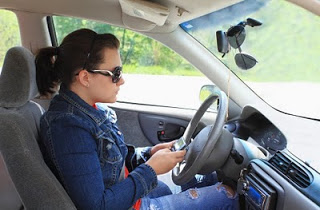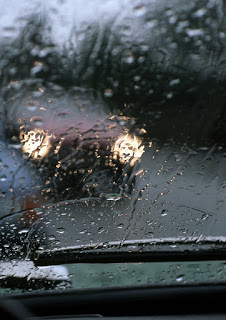Tag Archive: hazards

Reaching for Items in Your Vehicle and Distracted Driving
October 26, 2009
The hazard drivers create when they text or talk on cell phones has received considerable attention in the popular press recently. However, a more common distracted driving hazard is reaching for an item in the vehicle. Though cell phone use while driving is a significant problem, National Highway Traffic Safety Administration (NHTSA) studies indicate that it is a relatively small proportion of the distracted driving issue.
Driving distractions occur anytime something takes your eyes off the road, your hands off the steering wheel, or your mental attention from the task. Some distractions involve two or even all three of these. When you look for a particular song on a CD or MP3 player, your eyes turn from the road ahead, you remove at least one hand from the steering wheel, and you are temporarily preoccupied by the task of searching for the song you want to hear.
Other “reaching” distractions include:
- Eating
- Smoking
- Manipulating the controls of the aforementioned stereo, an in-vehicle navigation system or the climate control system
- Reaching for a fallen object
NHTSA estimates that drivers participate in potentially distracting activities about 30% of the time their vehicles are moving. Distraction may result in:
- loss of vehicle control
- unintended speed changes
- leaving the lane of travel
- missed opportunities to respond to changes in the driving scene
Though a motor vehicle crash caused by a driver reaching for something in the vehicle is not easily proved unless the driver admits to it, most drivers are aware of having driven while distracted by reaching for something in the vehicle.
“Reaching for something” does not have to mean reaching for an inanimate object. When they reach out to soothe, protect or discipline their children and pets, drivers’ attention is removed from the driving scene. Driving requires all your concentration, and parents should teach their children this and reinforce the lesson when necessary. Children should be fastened into appropriate safety restraint systems. While distractions aren’t good for you as a driver, they are great for children as passengers; DVDs, books, games, and small toys can keep them occupied until you reach your destination. If your children need attention, find a safe place to pull off the roadway. Your furry friend can travel safely in a pet carrier or safety harness. Never let your pet ride in your lap or roam around the vehicle while you drive.
Other ways to manage distractions include adjusting all of the vehicle’s controls before you start to drive and during stops at traffic lights, asking passengers to assist you when you need to get something inside your vehicle, and taking breaks to eat, drink and smoke.
Learning how to manage the distraction of reaching for things in your vehicle is a daunting task because it occurs so frequently. But doing so will allow you to keep you, your passengers, and other road users safe when you’re behind the wheel.

Environmental Effects on Driving a Car
January 29, 2009
We cannot avoid environmental conditions when we drive. Sometimes, conditions are favorable: a clear day with good visibility. Other times, challenging environmental conditions such as rain, fog and wind exist. Understanding how to properly handle these challenging conditions will make driving in them safer and less stressful.
Even a day filled with sunshine can present problems when driving. Too much light can make it difficult to see ahead. Wear sunglasses or use your sun visor. Always keep the lower edge of the sun visor pushed toward the windshield. Clean the inside of your windshield and all windows at least once per week. Sunshine on a dirty windshield creates glare.
Night driving requires adjustments too. The lack of light reduces detail and conceals hazards such as pedestrians, bicycles, stalled cars, and curves. It is more difficult to judge the speed and position of other vehicles. You must depend largely on your headlights, which will show only a relatively short and narrow path ahead. Headlights do not bend around corners; they will only illuminate what is directly in front of you. Highway lighting may be limited. Glare from roadway lights, business signs, and the headlights of oncoming vehicles may impair your visibility.
Other conditions that can greatly affect visibility are fog, haze, smoke and mist. Be especially careful of patches of fog in valleys and low-lying areas. It is best not to drive in fog or smoke. If you must, slow down, turn on your low beam headlights, and be ready for a fast stop. Be alert for slow-moving or stopped traffic. Check your rearview mirrors frequently for vehicles that are approaching quickly from the rear. Use windshield wipers in heavy fog. If the fog or smoke becomes so thick that you cannot see well enough to keep driving, pull off the road until conditions improve. Pull over as far to the right as possible, off the main travel portion of the roadway. Leave your parking lights on and activate your hazard lights.
During rainy conditions, wet roads will increase stopping distance. Roads are most slippery just after it begins to rain because the rain mixes with oil dropped from cars onto the road, creating a very slick surface.
When you are driving in the rain, slow down. Driving too fast in the rain makes hydroplaning more likely. When a car hydroplanes, the tires ride on a thin film of water instead of on the road. When this happens, you can easily lose control and skid. Your vehicle can hydroplane in as little as 1/16 of an inch of water. If the tread on your tires is worn, your vehicle is more likely to hydroplane. Besides slowing down, you can also reduce your chances of hydroplaning by making sure your tires have the right air pressure and good tread. If your vehicle hydroplanes, ease your foot off the gas and allow your vehicle to slow down until your tires gain traction with the road.
